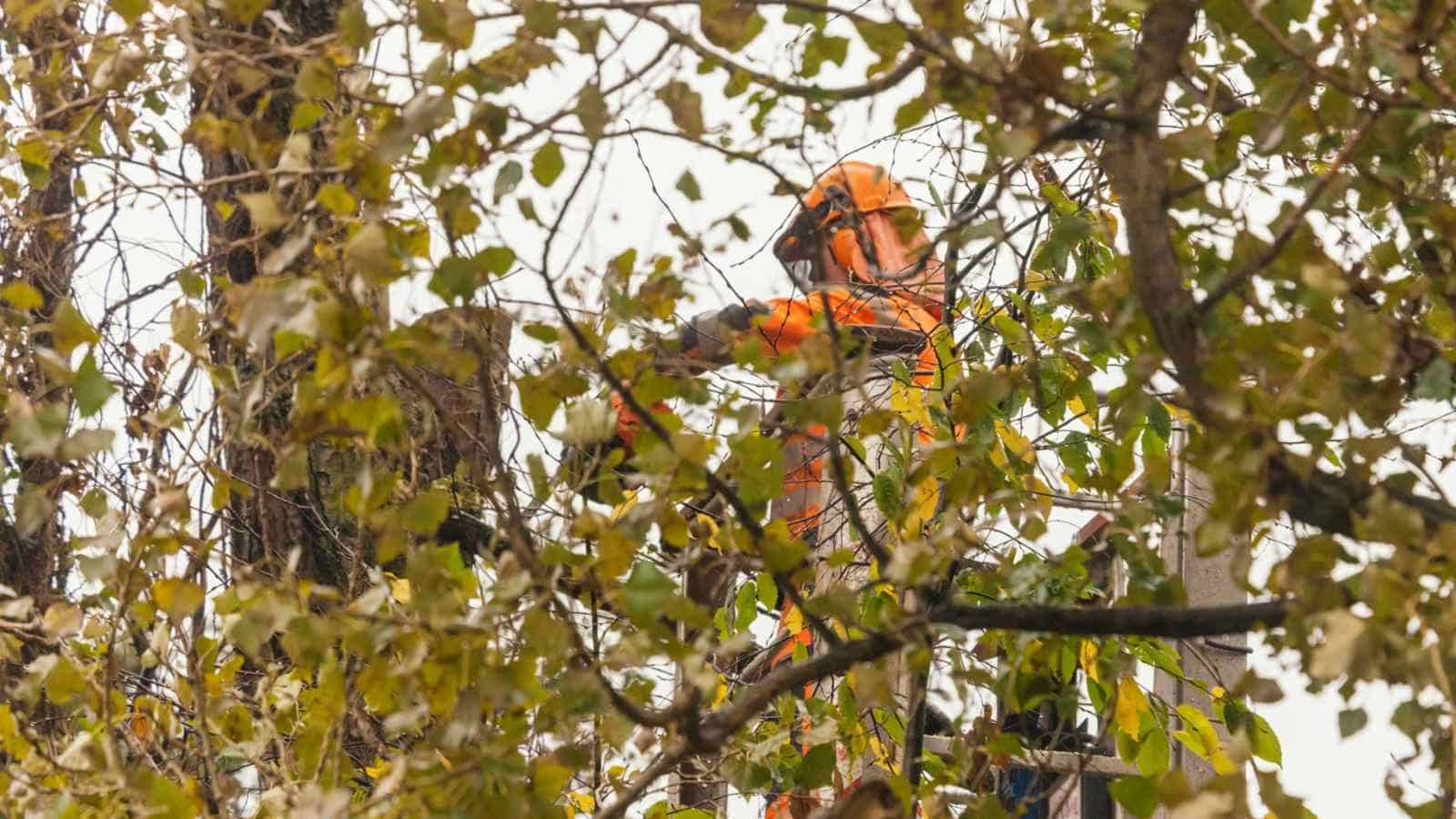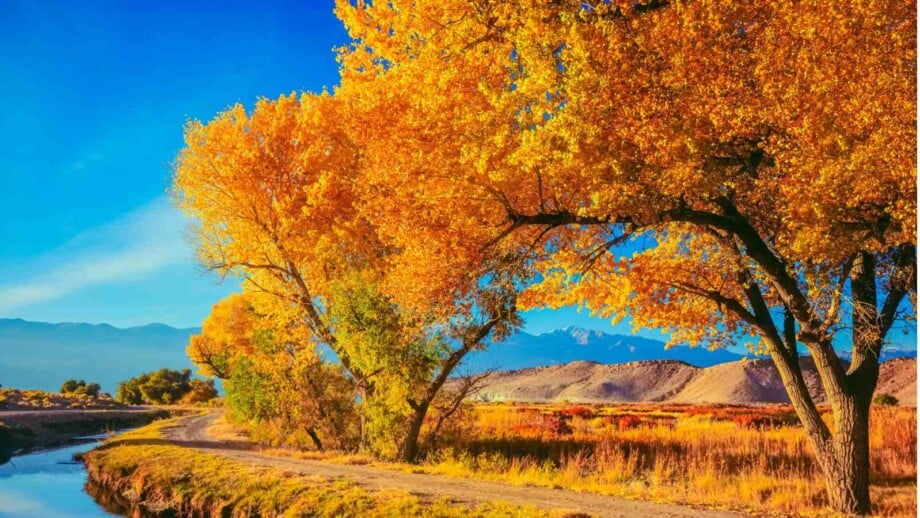Cottonwood tree, scientifically known as Populus deltoides, is a native tree of North America, commonly found from Southern Canada to Texas and Utah, and extends to the Rocky Mountains.
It is a popular component of many a landscape in the United States due to its stunning, grandeur presence and the enchanting rustle of its leaves. However, cultivating these trees requires a specific set of conditions and care.
This deciduous tree, known for its weak wood and propensity for the shedding of branches, sprouts heart-shaped leaves on long, flat petioles. These leaves, together with the trunk and bark, create a canopy that makes a perfect shade tree in the scorching early summer. Their vibrant green foliage transitions to a beautiful golden yellow in the fall, adding a pop of color to your garden.
Both male and female trees flower in the early spring, producing cotton-like strands that give the cottonwood its name. The female flowers form catkins hosting seeds enveloped in cottony strands, similar to their poplar relatives. You have to be careful though, separate trees are required for pollination.
The black cottonwood, known scientifically as Populus balsamifera, and the Fremont cottonwood, found in California and parts of Utah, produce similar buds and catkins, lending an air of unity despite the diversity in the species.
While cottonwoods are renowned for their shade and beauty, their secondary uses often go unnoticed. Notably, cottonwood trees are used in the production of plywood, a type of hardwood. Their bark can also be used for medicinal purposes, performing well as a natural pain killer.
As a master gardener, I’ve learned how to grow these stunning native trees over the past decade. And in this article, I’ll share everything you need to know to successfully grow them. Read on to learn more.

Botanical Name: Populus deltoides
Common Name: Cottonwood tree
Family: Salicaceae
Plant Type: Deciduous tree
Hardiness Zones: 2 – 9 (USDA)
Sun Exposure: Full sun
Soil Type: Well-drained soil
Soil pH: 5 – 7
Bloom Time: Catkins in early spring, female flowers produce cotton-like strands in early summer
Flower Color: Brownish-red
Native Area: North America, from Southern Canada through the United States into Mexico
Cottonwood Tree Plant Care
Cottonwood trees, native to North America, are deciduous trees that thrive in zones with full sun and well-drained soil with moderate pH.
The most common varieties in the United States include the Populus deltoides, known as the Eastern Cottonwood Tree, and the Populus balsamifera, also known as the Black Cottonwood.

Both trees, along with the Fremont Cottonwood native to California and Utah, require consistent moisture, especially in early spring and early summer. Despite their love for water, these majestic trees are also surprisingly drought-tolerant.
Prune in late winter to remove any weak wood and encourage new growth. Always check the leaves, bark, buds, and trunks for signs of pests or disease.
If you plant male and female trees separately, you will get to witness the beautiful sight of cotton-like strands from the female flowers, known as catkins, adorning your landscape by early summer.
Light
Cottonwood trees are deciduous trees native to North America that thrive in full sun. These trees prosper in landscapes exposed to an abundance of sunlight. The trees’ wide trunks and ample leaves, attached by thin petioles that allow them to rustle easily in the breeze, thirst for a lot of light.
In the cooler zones of the United States, as well as Southern Canada and the northern parts of the Rocky Mountains, these trees rely on the stronger summer sunlight to grow.
Therefore, when planning your landscape, consider a spot where these trees will get ample sunlight, as a shaded spot may limit their growth and overall health.

Soil
The soil needs of the cottonwood tree are rather flexible, demonstrating the tree’s adaptability across various landscapes.
Optimal growth of the cottonwood is usually observed in well-drained soil that retains moisture. The pH of the soil can range from acidic to alkaline, making the tree relatively easy to cultivate in different parts of North America.
This native tree resists drought fairly well, but thrives better with consistent moisture, a characteristic shared with its brethren – the poplar species.
Also notable is that given their vigorous growth, cottonwood trees can even tolerate somewhat compacted soil, although less healthy than their counterparts in well-drained environments.

Water
Cottonwood trees are native trees of North America that require ample moisture to thrive. Their affinity for well-drained soil keeps them from falling victim to drought, and their preference for full sun allows them to flourish in a variety of zones across the United States, from California to Utah, and North to Southern Canada.
However, these deciduous trees, recognizable by their broad leaves and sturdy trunks, shouldn’t be waterlogged. Overwatering may lead to weak wood, contributing to structural disabilities.
Appropriate watering throughout the early spring and early summer months will ensure healthy buds and lush foliage, as well as the delightful rustle of the leaves, a distinctive characteristic loved by many gardeners.
Temperature and Humidity
Cottonwood trees thrive in the climate conditions prevalent across many parts of the United States, including Utah, California, and large parts of North America, even extending up to Southern Canada.

These deciduous trees are native to zones that experience full sun and abundant moisture. They are not intensely heat or drought-resistant as it prefers areas with well-drained soil and air that contains a substantial quantity of moisture.
These leafy giants are fond of cooler temperature ranges in early spring and early summer when their catkins – flower clusters, begin to bud.
The combination of moisture, temperature, and sunlight found in these areas contributes to the cottonwood’s rapid growth rate.
Fertilizer
To thrive, cottonwood trees generally require well-drained soil and can survive with pH levels that vary. Owing to its native habitat along the riverbanks spanning from Southern Canada to California and stretching to Utah across the Rocky Mountains, they can tolerate occasional periods of drought but dictate a consistent supply of moisture for ideal growth.
A slow-release, balanced fertilizer can be applied in early spring to support budding, but it’s often unnecessary as they’re robust growers even in less fertile zones.
A robust shade tree, its foliage, characterized by large, rustling leaves on long petioles, will benefit from full sun exposure. The fertilizers will also fortify their weak wood trunks, making them less prone to breakage.
Pruning
Cottonwood trees are native trees of North America. They are deciduous trees with weak wood, making them highly susceptible to wind damage.

As such, regular pruning, preferably in early spring before the tree bud-burst occurs is highly recommended. It is primarily performed to remove dead, damaged or diseased branches and to maintain the tree structure.
Special attention should be given to the lower half of the tree where the leaves and bark are most dense – you’ll want to keep these areas as thin as possible to reduce wind resistance.
Since cottonwoods are massive shade trees, often growing in full sun, pruning should also ensure skylight penetration to the understory landscape.
It’s important to remember, however, that the hardwood tree’s bark and trunks are loved by various wildlife and insects, so a balance should be struck to keep the tree healthy and the ecosystem thriving.
Overwintering

Overwintering these giants involves ensuring that the weak wood trunks are not subjected to winter drought, a common occurrence in regions like the Rocky Mountains.
Additionally, careful attention must be paid to the buds, which lay dormant in the cold season, revealing catkins, or male and female flowers, in the early spring and summer.
Types of Cottonwood Tree
Here are some of the most common and popular types of cottonwood trees:
Eastern Cottonwood (Populus deltoides)

Renowned for its fast growth, the Eastern Cottonwood boasts a broad, cylindrical trunk and bark that is heavy and deeply ridged.
Its leaves, characterized by their distinctive rustle, flourish in full sun. These trees produce separate male and female flowers. The males produce catkins in early spring, while female trees harbor buds that burst into cotton-like strands from the early summer onwards.
Black Cottonwood (Populus balsamifera)

Black Cottonwood or Populus balsamifera is an imposing specimen that thrives from California up through the Rocky Mountains.
It prefers well-drained soil with a slightly acidic pH, and like its Eastern cousin, it is a deciduous tree that enjoys full sun. Its bark is a unique feature, dark and furrowed on mature trees.
The female Black Cottonwood displays lush catkins replete with cotton in early summer. However, it has earned a reputation for weak wood, making it less suitable in landscape design as a shade tree.
Fremont Cottonwood (Populus fremontii)

Fremont Cottonwood, native to the southwestern United States from Utah to California, has adapted to drier zones. Despite its ability to tolerate drought, it prefers well-drained, moist soils for optimal growth.
Petioles of the Fremont Cottonwood are flattened sideways, causing the leaves to rustle vibrantly in the wind. Interestingly, this species features male and female trees separately.
Male Fremont Cottonwoods produce purple catkins and are favored for their stronger wood, often used in plywood production, while females maintain the cottonwood tradition of casting cotton-like strands into the warm, early summer air.
How to Plant Cottonwood Tree from Seed
Seed Collection
Cottonwood trees are dichogamous, which means the female flowers on female trees and the male flowers on separate trees (male trees) mature at different times in early spring.

The female trees produce cotton-like strands with encapsulated seeds, known as catkins. Once these catkins mature in early summer, they break open to release the seeds.
The seeds can be collected from the ground beneath the tree or directly from the catkins once they start to open.
Seed Preparation
After collecting the seeds, remove any leftover catkin material and soak the seeds in water to help remove the cotton-like strands.

These small, cotton strands can make planting difficult, so it is advisable to remove as much as possible. After cleaning, allow the seeds to air dry.
Planting the Seeds
Cottonwoods are most suited to moist, well-drained soil, within a pH range of 5-7. Given that they are full sun lovers, ensure your planting site gets generous sun exposure.
Sow the seeds at about 0.5 inches deep into the soil and water adequately. You should see the buds sprouting from the seeds within a few days.
Caring for Your Cottonwood
As fast-growing trees, cottonwoods need regular water, but are also known to withstand periods of drought. Ensure consistent moisture without water logging the soil, as this could predispose the tree to weak wood development.

Young trees should be staked to safeguard against strong winds. Cottonwoods are also known for their delightful rustle sound when a breeze caresses the leaves attached to their flexible petioles.
How to Propagate Cottonwood Tree
Propagating cottonwood trees is easier than you think. Here’s how to do it step by step:
- Begin propagation in early spring before the buds sprout into leaf, while the trees are still dormant.
- Cut a hardwood branch of about 12-18 inches long from a healthy Cottonwood tree.
- Look for branches with multiple buds. Distinguish between male and female trees as they develop separate masculine catkins and feminine flowers. Males produce pollen while female trees yield cotton-like strands.
- Plant the cuttings directly in moist soil. The weak wood of the Cottonwood tree propagates effortlessly via cutting methods due to its exceptional moisture absorption capacity.
- Water your new tree adequately, especially during hot, dry periods to prevent drought.
Common Pests and Plant Diseases for Cottonwood Trees
Despite their hardy nature, these deciduous trees are also susceptible to various pests and diseases. Let’s look at the most common ones:
Aphids

One of the significant pests that thrive on cottonwood trees’ leaves are aphids. These small sap-sucking insects not only excrete a sticky substance on the leaves, reducing the tree’s aesthetic value, but they can also lead to yellowing and curling of leaves, eventually causing them to drop prematurely.
Cottonwood Borer

The Cottonwood borer, primarily found in the eastern cottonwood tree, gnaws recklessly at the trunk and bark of young and mature trees. In severe cases, it can cause weakening of the tree’s structure leading to breakage, especially given cottonwood’s already weak wood.
Beaver

Though not a pest in the traditional sense, beavers are known to damage cottonwood trees significantly. They gnaw and feed on the bark, leaving gnawed trunks and sometimes felling mature trees, particularly in regions like Utah.
Septoria Canker
Septoria Canker is a serious fungal disease affecting cottonwoods, including black cottonwood and Fremont cottonwood varieties. It attacks in early spring, entering the tree through wounds or buds. This disease can cause lesions on petioles and dieback of branches, which impacts the overall health of the tree.
Cottonwood Leaf Beetle
The Cottonwood Leaf Beetle is quite a pest for these trees. As both adults and larvae, they feed on the leaves and can strip a tree bare. If you hear the soothing rustle of cottonwood leaves replaced by bare silence, these critters are likely the cause.

Anthracnose
Anthracnose, caused by a fungus, can affect cottonwood trees, primarily in the moist zones of North America. Beginning with spots on leaves in early summer, it can progress to blight that may lead to premature leaf drop and twig dieback. Consistent yearly infection can reduce the shade tree’s vigor and lifespan.
Wetwood
Wetwood, also known as slime flux, is a bacterial disease. It affects the trunks and branches of cottonwood trees, causing a wet, slimy appearance that not only mars the appearance of the tree but can also lead to a decline in its overall health.
Common Plant Problems and Solutions for Cottonwood Trees

Brown Tips
Cottonwood trees can sometimes exhibit brown tips on their leaves. This could be due to a lack of moisture since these native trees of North America prefer well-drained soil but still require a good deal of water to thrive. To remedy this, ensure your tree is regularly watered, especially during dry spells or drought periods.
Yellowing Leaves
Yellowing of these can be a sign of overly moist soil or inadequate sunlight, as these species thrive in full sun zones. To counteract this, ensure your tree is planted in a location with proper drainage and receives plenty of sunlight daily.
Weak Wood
Cottonwoods are notorious for their weak wood. This can result in broken limbs and damage to trunks, particularly in separate trees that have been exposed to strong winds. Regular pruning in early spring, before the buds burst into catkins, can help reduce the likelihood of damage.
Other Tree Guides from Planet Natural:











